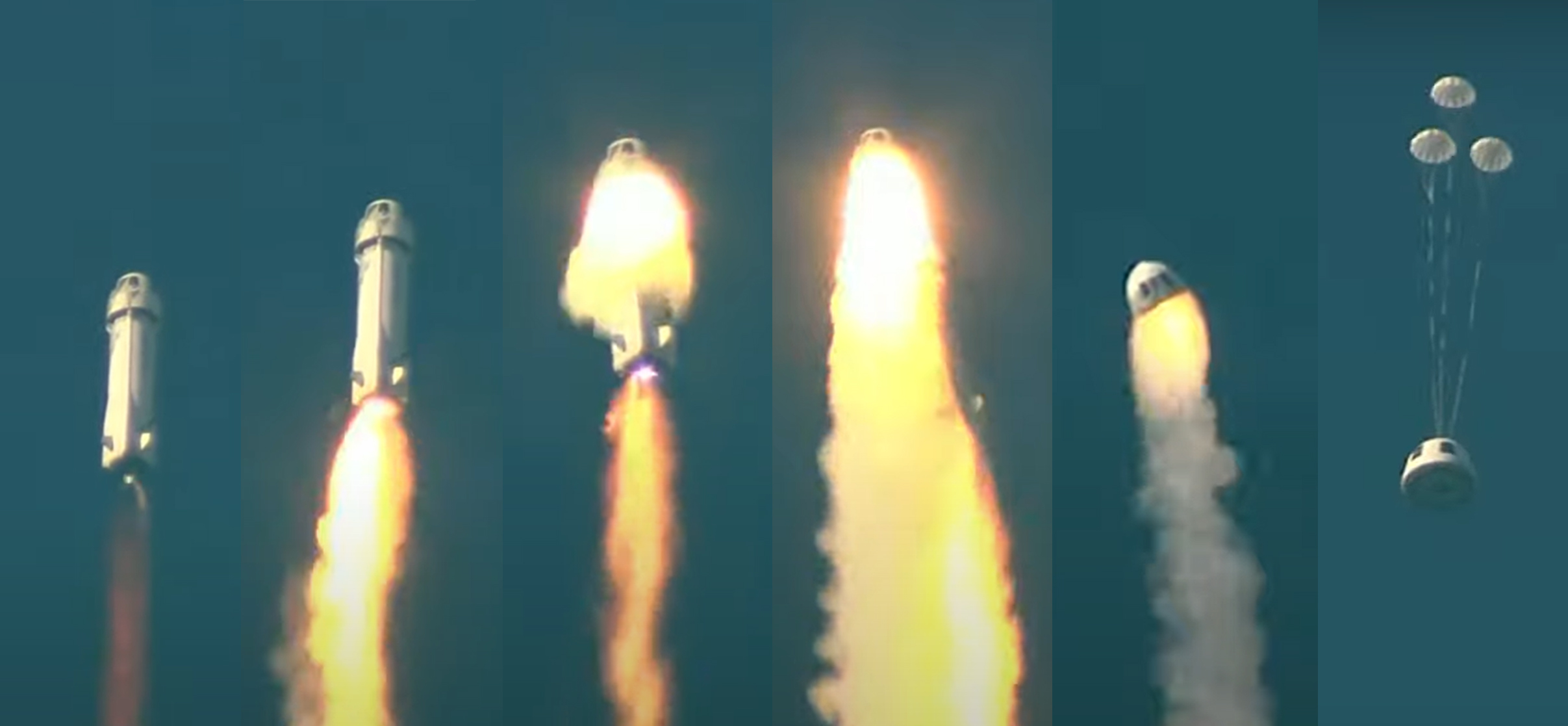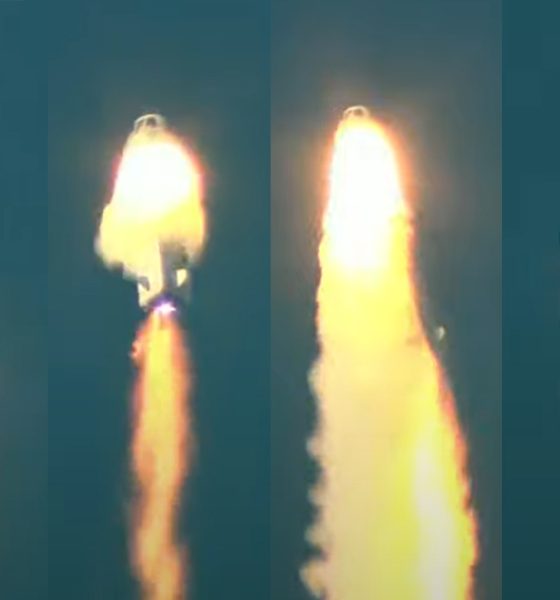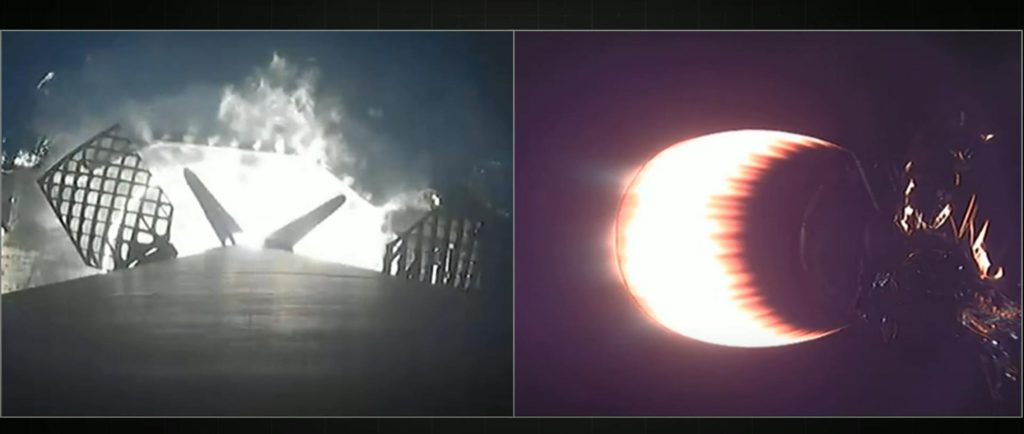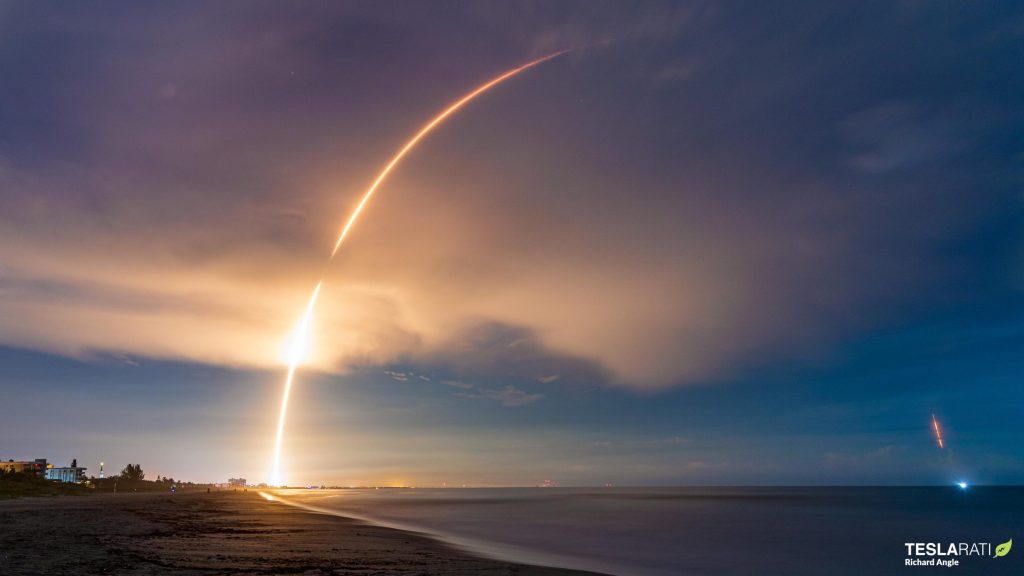

News
Blue Origin rocket launch fails after engine catches fire
Blue Origin’s suborbital New Shepard rocket suffered a catastrophic engine failure during its 23rd launch attempt, ending a seven-year streak of 21 successes.
Following a handful of mostly weather-related delays that pushed New Shepard’s 23rd launch about two weeks past its original August 31st target, the single-stage vehicle lifted off from Blue Origin’s Van Horn, Texas launch site around 10:25 am CDT (14:25 UTC) on September 12th. Measuring about 15 meters (49 ft) tall, 3.7 meters (12.1 ft) wide, and capable of producing about 50 tons (~110,000 lbf) of thrust with its lone BE-3 engine at full throttle, New Shepard only made it about halfway through its nominal powered ascent before catastrophe struck.
The first signs of trouble appeared about 62 seconds after liftoff in the form of flickers and flashes in New Shepard’s exhaust, which is normally almost transparent. Less than two seconds after the first seemingly harmless flash, flames unintentionally burst from New Shepard’s engine section and quickly surrounded its BE-3PM engine. Less than a second after that, the rocket’s aft and began shedding pieces and stopped producing thrust, triggering a solid rocket motor stored inside its deployable capsule.
About a second after the incident began, the capsule’s abort motor ignited and carried the suborbital spacecraft safely away from the failing New Shepard booster. The capsule ultimately coasted to an apogee of 11.4 kilometers (7.1 miles) – almost ten times lower than nominal – before descending back to Earth, deploying its parachute system, and safely touching down in the Texas desert scrub. Thankfully, NS-23 was only carrying experiments, and no humans were at risk. Had a crew of suborbital tourists been aboard, they would have likely been a little battered but otherwise completely unharmed.
..there is room for a lot of speculation ?– i did a frame by frame Picture – on the bottom row you can see some parts falling away. maybe the nozzle fell apart?!? pic.twitter.com/OOzPkPiX6G— Flo (@FloSpacenerd) September 12, 2022
While any failure of a rocket is unfortunate, the failure of a rocket nominally designed to launch humans can have even worse repercussions. However, thanks to the seemingly flawless unplanned performance of New Shepard’s abort system, it’s safe to say that the day could have gone much worse for Blue Origin.
The failure is still not going to do the reputation of Blue Origin or New Shepard any favors. It also invites less than favorable comparisons with SpaceX, a different spaceflight startup also funded and founded by a tech tycoon in the early 2000s.
Founded a year and a half after Blue Origin, SpaceX, in comparison, reached orbit with Falcon 1 in 2008. In June 2010, it successfully debuted Falcon 9, an orbital-class rocket roughly 20 times larger. In 2012, Falcon 9 successfully launched an orbital Dragon spacecraft which became the first private vehicle to dock to the International Space Station. In January 2015, it attempted to recover a Falcon 9 booster for the first time. In December 2015, one month after Blue Origin’s first successful New Shepard landing, SpaceX aced its first Falcon 9 booster landing.
Nine months later, Falcon 9 suffered a catastrophic failure during prelaunch testing in September 2016 and didn’t return to flight until January 2017. That is where, for the most part, the paths of Blue Origin and SpaceX almost entirely diverged – but not in any obvious way. Instead, after a successful suborbital launch in October 2016, New Shepard didn’t fly again until December 2017. In the roughly six years between October 2016 and September 2022, New Shepard completed 10 uncrewed suborbital launches, 6 suborbital tourist launches, and suffered one failure during another uncrewed mission – 18 total launches.
Despite suffering a catastrophic failure that destroyed a customer’s multimillion-dollar satellite in September 2016, SpaceX returned to flight four months later, completed 150 orbital Falcon launches without fail in the same period; debuted the world’s largest operational rocket, Falcon Heavy, and completed two additional launches with it; debuted Crew Dragon and Cargo Dragon 2 on Falcon 9; launched its first astronauts into orbit, launched its first operational astronaut transport mission for NASA, launched its first two Starlink internet satellite prototypes, launched another 60 refined Starlink prototypes, began operational Falcon 9 Starlink launches, built and launched more than 3000 Starlink satellites total; landed 130+ Falcon boosters, and reuse Falcon boosters 117 times.


The differences could not be more stark or strange, given that both companies have been operating more or less side by side and working towards similar goals for as long as they’ve existed. To Blue Origin’s credit, the company managed a record six New Shepard launches – three carrying tourists – in 2021. NS-23 was its fourth planned launch in 2022, suggesting that it could have achieved a similar cadence this year if the mission had had a different fate. Instead, the launch failure has triggered an anomaly investigation that will search for the root cause and try to uncover shortcomings that will then need to be rectified before New Shepard can return to flight. Given that Blue Origin once went 15 months between successful New Shepard launches, it’s impossible to say how long that process will take.
In the meantime, the apparent failure of New Shepard’s BE-3PM engine could trigger investigations into Blue Origin’s other engine programs. While substantially different, BE-3U, a variant optimized for the upper stage of New Glenn, Blue Origin’s first orbital rocket, likely shares the most in common with New Shepard’s BE-3PM. BE-7, a small engine meant to power a Moon lander, could also be impacted.
Most importantly, Blue Origin is also in the midst of finally preparing two much more powerful and far more complex BE-4 engines for customer United Launch Alliance (ULA). Years behind schedule, Blue Origin completed the first two theoretically flightworthy BE-4 engines and began putting them through qualification testing earlier this year. It wants to ship those engines to ULA as soon as possible to avoid delaying the debut of the customer’s new Vulcan Centaur rocket. BE-3PM and BE-4 probably don’t share a single part, but many Blue Origin employees have likely worked on both programs, and the same Blue Origin leadership has certainly overseen both. As long as there’s any form of commonality, no matter how abstract, there’s always a risk that the underlying cause of problems in one program could be present in others.
Ultimately, it’s unlikely that there will be any serious connection. The New Shepard booster that failed on NS-23 was almost five years old and was flying for a record-breaking ninth time. It’s possible that Blue Origin was privately worried about the possibility of failure while pushing the envelope, but it offered no qualifications while discussing the mission. SpaceX CEO Elon Musk, in comparison, has almost always made it clear that failure is a possibility when the company attempts ‘firsts’ of any kind.
SpaceX recently launched and recovered the same Falcon 9 booster for the 14th time, setting its own internal record. As a result, that lone Falcon 9 booster, B1058, has flown as many times in the last 31 months as all New Shepard boosters combined have flown in the last 45 months.
Finally, while no company should be put in that position, Blue Origin deserves praise for its live coverage of the anomaly. Instead of immediately cutting the feeds, which would be what most providers would be expected to do during an operational launch, Blue Origin continued to broadcast views of the failure and provide live commentary until New Shepard’s capsule touched down well ahead of schedule.

News
Tesla 2025 Holiday Update: Here’s what it includes, and what it’s missing

Tesla has finally announced the features for the 2025 Holiday Update, which includes a wide variety of new inclusions that are both functional and just for fun.
The new features are plentiful, but there were a handful of things we were expecting to see based on what we know. We don’t want to sound ungrateful, because there are a lot of great new things on the way with this update.
Here’s what was included:
Grok with Navigation Commands (Beta)
Grok will now have the ability to add and edit navigation destinations, which is a drastic improvement considering Tesla owners had to use their standard voice commands for this in the past.

The utilization of Grok will likely improve the navigation experience by offering some insight into your destination, including reviews and other points of interest nearby.
It will be enabled by using Grok’s “Assistant” personality.
Tesla Photobooth
“Turn your car into a photobooth! Take selfies from inside your Tesla & give yourself a makeover with fun filters, stickers, and emojis. Share with others right from the Tesla app.”
This feature will be available within the Toybox.
Dog Mode Live Activity
When using Dog Mode to keep your four-legged friend comfortable in the car, you’ll now be able to check in on them as it will share periodic snapshots of the cabin, along with live updates on temperature, battery, and climate conditions.

Dashcam Viewer Update
Dashcam clips are awesome, but they’re void of a lot of information, which could be useful in some instances, especially if there is an accident.

Now, there will be additional details included on each Dashcam clip, like speed, steering wheel angle, and Self-Driving state.
Santa Mode
New graphics, trees, and a lock chime are now available.

Light Show Update
A new Light Show, called Jingle Rush, will be available.
Custom Wraps and License Plates in Colorizer
Colorizer will now be known as “Paint Shop” in the Toybox. You will now be able to personalize your Tesla Avatar with window tints, custom wraps, and license plates. Preloaded designs will be available, but owners will be able to use their USB Flash Drives to create one that suits their style.

Navigation Improvements
Changing the order of your destinations will be easier through a new “Favorites” tab, and Home and Work can now be set by dropping a pin.
There will also be “Suggested Destinations,” which will be determined through recent trips and habits while parked.
Supercharger Site Map
Perhaps the most significant feature of the Holiday Update, Tesla is adding a 3D view of select Tesla Superchargers by tapping “View Site Map.”
When navigating to a location with this capability, the site layout, live occupancy, and nearby amenities will be available. Drivers will also be able to choose which stall to Supercharge.

This is only available at a handful of locations currently, but it will expand to more Superchargers as it becomes more robust.
Automatic Carpool Lane Routing
Navigation will include an option to utilize carpool lanes. Your route will automatically choose the carpool lane when eligible.
Phone Left Behind Chime
If the in-car occupant detection system does not see anyone in the car and there is a phone key, or if a phone is left inside the cabin, your Tesla will chime a few seconds after the doors close.
Charge Limit Per Location
You can now save a charge limit for the current location while parked and it will be applied automatically the next time you charge there.
ISS Docking Simulator
In a SpaceX collaboration, Tesla has added this game to its in-car Arcade:
“Become an astronaut and prove your skills by docking with the International Space Station. Control & guide the rocket in this 3D docking simulator game using a set of controls based on actual interfaces used by NASA astronauts.”
Additional Improvements
-
Enable or disable wireless phone charging pads in Controls > Charging (S3XY) or Controls > Outlets & Mods (Cybertruck)
-
Add Spotify tracks to your queue right from the search screen & scroll through large Spotify playlists, albums, podcasts, audiobooks & your library seamlessly, without paging
-
Take the vibes up another level with rainbow colors during Rave Cave. Accent lights color will change along with the beats of your music. App Launcher > Toybox > Light Sync
-
Lock Sound now includes Light Cycle from Tron Mode. Toybox > Boombox > Lock Sound
What’s Missing
There are a handful of features we expected to see with the Holiday Update, but were not included.
Banish Feature
Tesla has been teasing the Banish functionality for quite a few years, but evidently, it is not quite there yet.
Banish will allow owners to get out of their vehicle at the entrance of their destination, and the car will go find a spot and park itself. Some refer to it as “Reverse Summon.”
Apple CarPlay
With all of the rumors regarding Apple CarPlay and then the evidence that Tesla was working to bring CarPlay to vehicles, we really expected it to come with the Holiday Update.
We’re not upset it’s not here, though. Tesla’s in-car UI is significantly better, at least in our opinion.
Parking Spot Selection
One of the biggest gripes about the new Arrival Features with Full Self-Driving v14 is that choosing a set parking spot is not available. This is especially frustrating for Tesla owners who rent or live in townhouse neighborhoods or apartment complexes with assigned parking.
Tesla seems to be working on this based on the release notes for v14.2, where it said future capabilities would include Parking Spot Selection.
News
Man credits Grok AI with saving his life after ER missed near-ruptured appendix
The AI flagged some of the man’s symptoms and urged him to return to the ER immediately and demand a CT scan.

A 49-year-old man has stated that xAI’s Grok ended up saving his life when the large language model identified a near-ruptured appendix that his first ER visit dismissed as acid reflux.
After being sent home from the ER, the man asked Grok to analyze his symptoms. The AI flagged some of the man’s symptoms and urged him to return immediately and demand a CT scan. The scan confirmed that something far worse than acid reflux was indeed going on.
Grok spotted what a doctor missed
In a post on Reddit, u/Tykjen noted that for 24 hours straight, he had a constant “razor-blade-level” abdominal pain that forced him into a fetal position. He had no fever or visible signs. He went to the ER, where a doctor pressed his soft belly, prescribed acid blockers, and sent him home.
The acid blockers didn’t work, and the man’s pain remained intense. He then decided to open a year-long chat he had with Grok and listed every detail that he was experiencing. The AI responded quickly. “Grok immediately flagged perforated ulcer or atypical appendicitis, told me the exact red-flag pattern I was describing, and basically said “go back right now and ask for a CT,” the man wrote in his post.
He copied Grok’s reasoning, returned to the ER, and insisted on the scan. The CT scan ultimately showed an inflamed appendix on the verge of rupture. Six hours later, the appendix was out. The man said the pain has completely vanished, and he woke up laughing under anesthesia. He was discharged the next day.
How a late-night conversation with Grok got me to demand the CT scan that saved my life from a ruptured appendix (December 2025)
byu/Tykjen ingrok
AI doctors could very well be welcomed
In the replies to his Reddit post, u/Tykjen further explained that he specifically avoided telling doctors that Grok, an AI, suggested he get a CT scan. “I did not tell them on the second visit that Grok recommended the CT scan. I had to lie. I told them my sister who’s a nurse told me to ask for the scan,” the man wrote.
One commenter noted that the use of AI in medicine will likely be welcomed, stating that “If AI could take doctors’ jobs one day, I will be happy. Doctors just don’t care anymore. It’s all a paycheck.” The Redditor replied with, “Sadly yes. That is what it felt like after the first visit. And the following night could have been my last.”
Elon Musk has been very optimistic about the potential of robots like Tesla Optimus in the medical field. Provided that they are able to achieve human-level articulation in their hands, and Tesla is able to bring down their cost through mass manufacturing, the era of AI-powered medical care could very well be closer than expected.
News
Tesla expands Model 3 lineup in Europe with most affordable variant yet
The Model 3 Standard still delivers more than 300 miles of range, potentially making it an attractive option for budget-conscious buyers.

Tesla has introduced a lower-priced Model 3 variant in Europe, expanding the lineup just two months after the vehicle’s U.S. debut. The Model 3 Standard still delivers more than 300 miles (480 km) of range, potentially making it an attractive option for budget-conscious buyers.
Tesla’s pricing strategy
The Model 3 Standard arrives as Tesla contends with declining registrations in several countries across Europe, where sales have not fully offset shifting consumer preferences. Many buyers have turned to options such as Volkswagen’s ID.3 and BYD’s Atto 3, both of which have benefited from aggressive pricing.
By removing select premium finishes and features, Tesla positioned the new Model 3 Standard as an “ultra-low cost of ownership” option of its all-electric sedan. Pricing comes in at €37,970 in Germany, NOK 330,056 in Norway, and SEK 449,990 in Sweden, depending on market. This places the Model 3 Standard well below the “premium” Model 3 trim, which starts at €45,970 in Germany.
Deliveries for the Standard model are expected to begin in the first quarter of 2026, giving Tesla an entry-level foothold in a segment that’s increasingly defined by sub-€40,000 offerings.
Tesla’s affordable vehicle push
The low-cost Model 3 follows October’s launch of a similarly positioned Model Y variant, signaling a broader shift in Tesla’s product strategy. While CEO Elon Musk has moved the company toward AI-driven initiatives such as robotaxis and humanoid robots, lower-priced vehicles remain necessary to support the company’s revenue in the near term.
Reports have indicated that Tesla previously abandoned plans for an all-new $25,000 EV, with the company opting to create cheaper versions of existing platforms instead. Analysts have flagged possible cannibalization of higher-margin models, but the move aims to counter an influx of aggressively priced entrants from China and Europe, many of which sell below $30,000. With the new Model 3 Standard, Tesla is reinforcing its volume strategy in Europe’s increasingly competitive EV landscape.








